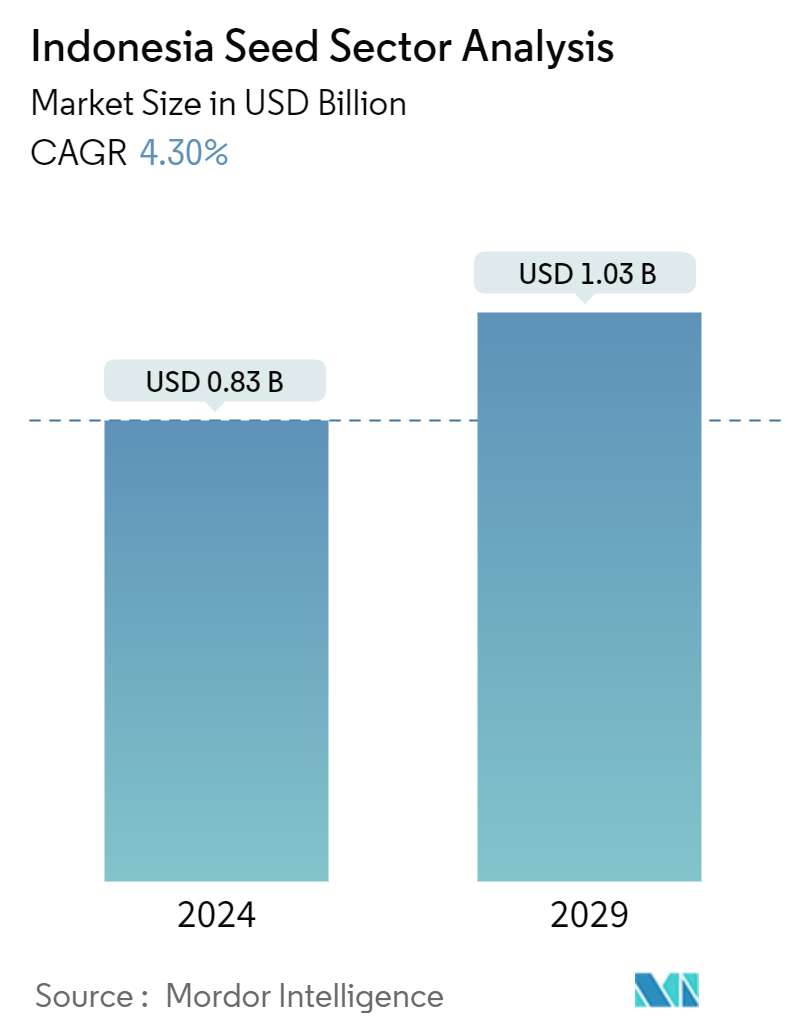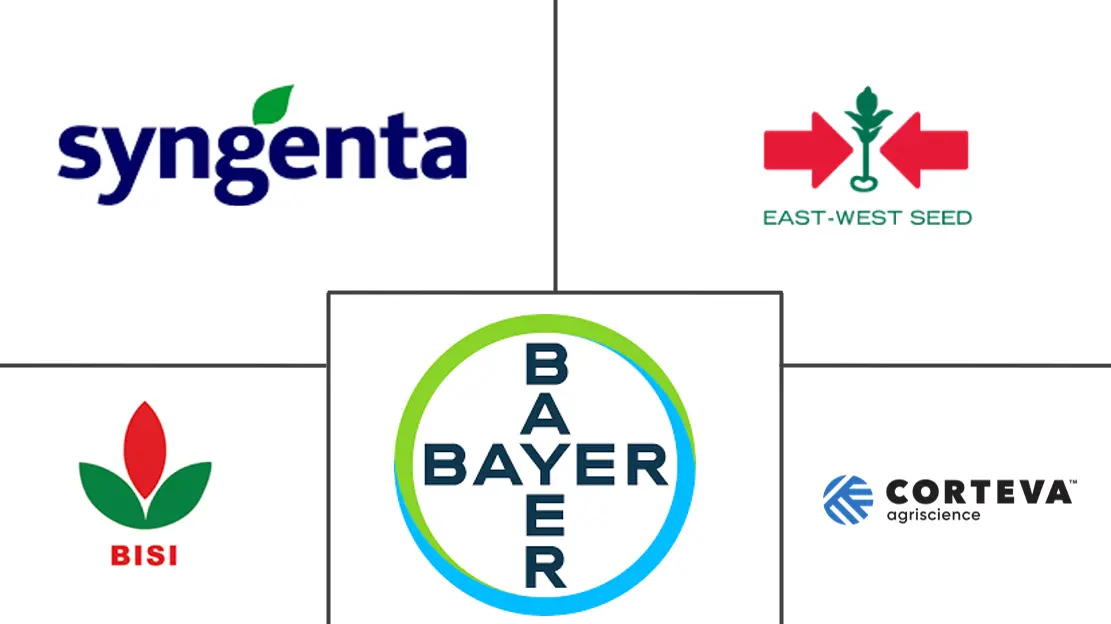Market Size of Indonesia Seed Industry

| Study Period | 2019 - 2029 |
| Base Year For Estimation | 2023 |
| Market Size (2024) | USD 0.83 Billion |
| Market Size (2029) | USD 1.03 Billion |
| CAGR (2024 - 2029) | 4.30 % |
| Market Concentration | Medium |
Major Players
*Disclaimer: Major Players sorted in no particular order |
Indonesia Seed Market Analysis
The Indonesia Seed Market size is estimated at USD 0.83 billion in 2024, and is expected to reach USD 1.03 billion by 2029, growing at a CAGR of 4.30% during the forecast period (2024-2029).
Rice is a pivotal staple in Indonesia, significantly influencing the nation's economy. As farmers increasingly recognize the advantages of certified seeds, the demand for these quality seeds is set to surge, promising higher crop yields in the coming years. This growing demand reflects farmers' readiness to invest more in superior seeds. With per capita arable land diminishing, farmers are turning to high-yielding and hybrid seed varieties to boost profitability. Consequently, there's a marked shift among Indonesian farmers from traditional farm-saved seeds to premium packaged seeds, all in pursuit of enhanced returns.
As per the 2023 Indonesia Grain and Feed Annual Report by the USDA, Java accounted for 50% to 55% of the nation's rice production. Sumatra and Sulawesi followed, contributing 20% and 12%, respectively. Notably, about 85% of this rice was cultivated in irrigated paddy fields, hinting at a growing potential for high-yield seed varieties in the future.
Moreover, with opportunities to cultivate corn in the second and third cycles, driven by lucrative corn prices and the adoption of high-yield varieties, projections for 2022-2023 showed corn cultivation to span 3.95 million ha, yielding 12.9 million metric tons. This surge in production, coupled with expanded wet mill capacities and the establishment of new ethanol plants, elevated corn imports to 1.2 million metric tons during 2022-2023, up from 1.165 million metric tons in the previous year.
Additionally, major companies and government entities are bolstering distribution efforts in the seed market, fueling its expansion. For example, in June 2023, the Ministry of Agriculture rolled out 4 metric tons of a new superior rice seed across multiple provinces, including South Sumatra, Lampung, Banten, West Java, Central Java, East Java, South Sulawesi, and West Sumatra. The diverse rice seed varieties distributed include Inpago 9, Inpago 12, Inpago 13 Foriz, Cakrabuana, and Inpari 42. Consequently, heightened awareness of certified seeds, bolstered by increased investments in seed innovations, government backing, and the diverse product offerings of companies, are expected to propel market growth during the forecast period.
Indonesia Seed Industry Segmentation
A seed is a fertilized mature ovule consisting of the embryo, stored material, and protective coats for crop production. The Indonesian seed sector report is segmented by crop type into row crops and vegetables and product into non-GM/hybrid seeds, GM seeds, and varietal seeds. The report offers market estimation and forecasts in value (USD) and volume (metric tons) for the segments mentioned above.
| By Crop Type | |||||||
| |||||||
|
| By Product | |
| Non-GM/Hybrid Seeds | |
| GM Seeds | |
| Varietal Seeds |
Indonesia Seed Market Size Summary
The Indonesian seed market is experiencing growth driven by increasing demand for feed grains and horticulture products. The market is characterized by a fragmented landscape with numerous players, both international and regional, competing for market share. Key companies such as PT DuPont Indonesia, PT. Bayer Indonesia, and Syngenta are actively involved in the market, employing strategies like mergers, acquisitions, and investments in research to enhance their seed portfolios. The government's initiatives, including incentives for corn production and subsidies on fertilizers and seeds, are boosting the corn seed market, while the continued ban on corn imports is propelling the wheat seed market. The domestic demand for horticulture products is also rising, leading to increased imports and providing opportunities for seed breeders to tap into the market.
The Indonesian government's efforts to improve local production and shorten distribution channels are aimed at enhancing the quality and supply of horticultural products. Despite the challenges of inconsistent domestic supply and poor management facilities, the demand from middle-income families is driving growth in the sector. The market's competitive nature is further intensified by the presence of notable players who are continuously innovating and expanding their operations. Recent developments, such as the launch of new seed varieties and the establishment of new facilities, underscore the dynamic nature of the market. These efforts are crucial in meeting the growing domestic and international demand for high-quality seeds and agricultural products in Indonesia.
Indonesia Seed Market Size - Table of Contents
-
1. MARKET DYNAMICS
-
1.1 Market Overview
-
1.2 Market Drivers
-
1.3 Market Restraints
-
1.4 Porter's Five Forces Analysis
-
1.4.1 Bargaining Power of Suppliers
-
1.4.2 Bargaining Power of Buyers/Consumers
-
1.4.3 Threat of New Entrants
-
1.4.4 Threat of Substitute Products
-
1.4.5 Intensity of Competitive Rivalry
-
-
-
2. MARKET SEGMENTATION
-
2.1 By Crop Type
-
2.1.1 Row Crops
-
2.1.1.1 Rice
-
2.1.1.2 Maize
-
2.1.1.3 Soybean
-
2.1.1.4 Groundnut
-
2.1.1.5 Other Row Crops
-
-
2.1.2 Vegetables
-
2.1.2.1 Chilli
-
2.1.2.2 Onion
-
2.1.2.3 Cabbage
-
2.1.2.4 Tomato
-
2.1.2.5 Other Vegetables
-
-
-
2.2 By Product
-
2.2.1 Non-GM/Hybrid Seeds
-
2.2.2 GM Seeds
-
2.2.3 Varietal Seeds
-
-
Indonesia Seed Market Size FAQs
How big is the Indonesia Seed Market?
The Indonesia Seed Market size is expected to reach USD 0.83 billion in 2024 and grow at a CAGR of 4.30% to reach USD 1.03 billion by 2029.
What is the current Indonesia Seed Market size?
In 2024, the Indonesia Seed Market size is expected to reach USD 0.83 billion.

